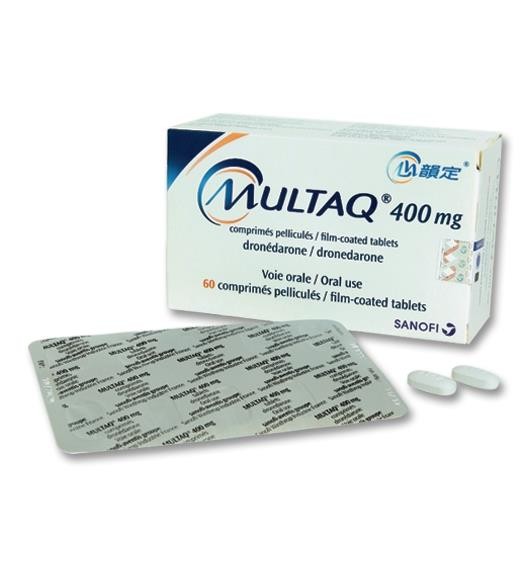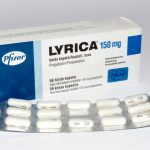
Contents
- 1 Multaq (dronedarone)
Multaq (dronedarone)
Multaq is a prescription medicine used to lower the chance of hospitalization for atrial fibrillation. It is for people who have had paroxysmal or persistent AF in the past, but are now in normal rhythm.
Multaq’s safety and effectiveness in children under 18 years old is unknown.
Side effects of Multaq
WARNING
RISK OF DEATH, STROKE, AND HEART FAILURE IN PATIENTS WITH DECOMPENSATED HEART FAILURE OR PERMANENT ATRIAL FIBRILLATION
Multaq doubles the risk of death in patients with symptomatic heart failure and recent decompensation requiring hospitalization or NYHA Class IV heart failure. It is contraindicated in these patients.
Multaq also doubles the risk of death, stroke, and hospitalization for heart failure in patients with permanent atrial fibrillation. It is contraindicated in patients with AF who will not or cannot be cardioverted into normal sinus rhythm.
Multaq may cause serious side effects, including:
- Slowed heartbeat (bradycardia)
- Inflammation of the lungs, including scarring and thickening. Call your doctor if you develop shortness of breath or a dry cough during treatment with Multaq.
- Low potassium and magnesium levels in your blood. This can happen if you take certain water pills (diuretics) during treatment with Multaq. Your doctor may check you for this problem before and during treatment.
- Changes in kidney function blood tests after starting Multaq. Your doctor may check you for this during treatment.
The most common side effects of Multaq include:
- diarrhea
- nausea
- vomiting
- abdominal pain
- indigestion
- fatigue
- skin problems such as redness, rash, and itching
Tell your doctor about any bothersome or persistent side effect. This is not a complete list of Multaq’s side effects. For more information, consult your doctor or pharmacist.
Contact your doctor for medical advice about side effects. Report side effects to the FDA at 1-800-FDA-1088.
Dosage for Multaq
The recommended dosage of Multaq is 400 mg twice daily in adults. Take one tablet with the morning meal and one tablet with the evening meal.
Treatment with Class I or III antiarrhythmics or strong CYP3A inhibitors must be stopped before starting Multaq.
Drug interactions with Multaq
Pharmacodynamic Interactions
Drugs Prolonging The QT Interval (Inducing Torsade de Pointes)
- Coadministration of drugs prolonging the QT interval is contraindicated due to the potential risk of torsade de pointes-type ventricular tachycardia.
Digoxin
- In the ANDROMEDA and PALLAS trials, baseline use of digoxin increased the risk of arrhythmic or sudden death in dronedarone-treated patients compared to placebo.
- No difference in the risk of sudden death was observed in patients not taking digoxin.
- Digoxin can potentiate the electrophysiologic effects of dronedarone. Dronedarone increases exposure to digoxin.
- Consider discontinuing digoxin. If continued, halve the dose, monitor serum levels closely, and observe for toxicity.
Calcium Channel Blockers
- Calcium channel blockers with depressant effects on the sinus and AV nodes could potentiate dronedarone’s effects on conduction.
- Start with a low dose and increase only after ECG verification of good tolerability.
Beta-Blockers
- Bradycardia was more frequently observed when dronedarone was given in combination with beta-blockers in clinical trials.
- Start with a low dose and increase only after ECG verification of good tolerability.
Effects Of Other Drugs On Dronedarone
Ketoconazole And Other Potent CYP 3A Inhibitors
- Concomitant use of ketoconazole and other potent CYP 3A inhibitors is contraindicated as it significantly increases exposure to dronedarone.
Grapefruit Juice
- Avoid grapefruit juice beverages while taking Multaq as it significantly increases exposure to dronedarone.
Rifampin And Other CYP 3A Inducers
- Avoid rifampin or other CYP 3A inducers as they significantly decrease exposure to dronedarone.
Calcium Channel Blockers
- Verapamil and diltiazem are moderate CYP 3A inhibitors and increase dronedarone exposure.
- Start with a low dose and increase only after ECG verification of good tolerability.
Effects Of Dronedarone On Other Drugs
Simvastatin
- Dronedarone increased simvastatin/simvastatin acid exposure. Avoid doses greater than 10 mg once daily of simvastatin.
Other Statins
- Follow statin label recommendations for use with CYP 3A and P-gp inhibitors, such as dronedarone.
Calcium Channel Blockers
- Dronedarone increased the exposure of calcium channel blockers (verapamil, diltiazem, or nifedipine).
- Start with a low dose and increase only after ECG verification of good tolerability.
Sirolimus, Tacrolimus, And Other CYP3A Substrates With Narrow Therapeutic Range
- Dronedarone can increase plasma concentrations of tacrolimus, sirolimus, and other CYP 3A substrates with a narrow therapeutic range. Monitor plasma concentrations and adjust dosage accordingly.
Beta-Blockers And Other CYP2D6 Substrates
- Dronedarone increased the exposure of propranolol and metoprolol.
- Start with low doses of beta-blockers and increase only after ECG verification of good tolerability.
- Other CYP2D6 substrates, including other beta-blockers, tricyclic antidepressants, and selective serotonin reuptake inhibitors (SSRIs), may have increased exposure when coadministered with dronedarone.
P-glycoprotein Substrates
Digoxin
- Dronedarone increased digoxin exposure by inhibiting the P-gp transporter. Consider discontinuing digoxin. If continued, halve the dose, monitor serum levels closely, and observe for toxicity.
Dabigatran
- Exposure to dabigatran is higher when administered with dronedarone than when administered alone.
- Other P-gp substrates are expected to have increased exposure when coadministered with dronedarone.
Warfarin
- Exposure to S-warfarin was slightly higher when coadministered with dronedarone than when administered alone. There were no clinically significant increases in INR.
- More patients experienced clinically significant INR elevations (≥ 5), usually within 1 week after starting dronedarone, but no excess risk of bleeding was observed in the dronedarone group.
- Monitor INR after initiating dronedarone in patients taking warfarin.
Is Multaq safe to use while pregnant or breastfeeding?
- Multaq may cause fetal harm when used during pregnancy. Pregnant patients should be aware of the potential hazard to the fetus.
- It is not known whether Multaq is excreted in human milk. Dronedarone and its metabolites are excreted in rat milk.
- During a prenatal and postnatal study in rats, maternal dronedarone administration was associated with minor reduced bodyweight gain in the offspring.
- Because many drugs are excreted in human milk and due to the potential for serious adverse reactions in nursing infants, discontinue nursing or discontinue Multaq.
Summary
Multaq is a prescription medicine used to lower the chance of hospitalization for atrial fibrillation. It is for people who have had paroxysmal or persistent AF in the past, but are now in normal rhythm. Taking Multaq is associated with an increased risk of death, stroke, and heart failure in people with decompensated heart failure or permanent atrial fibrillation.


